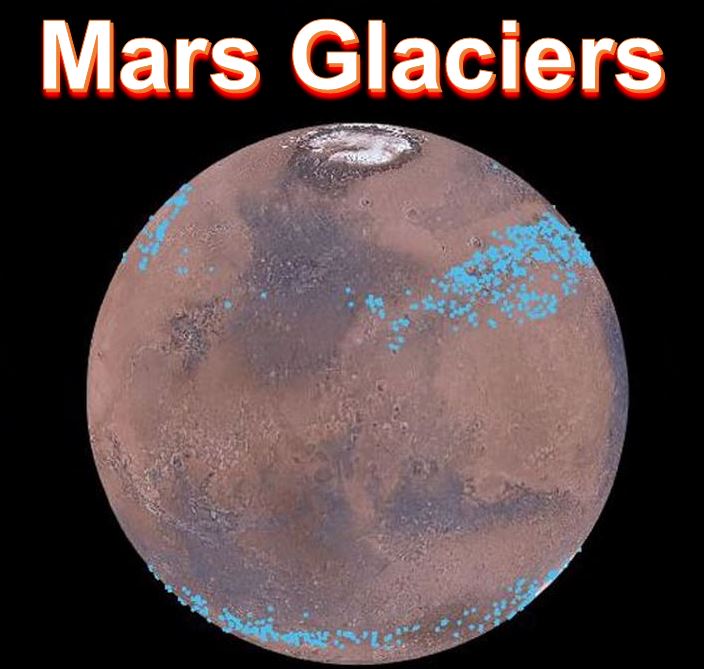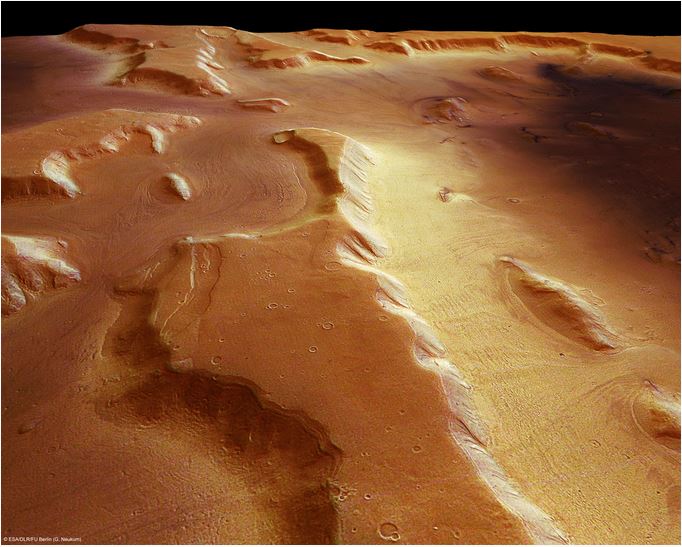Below the thick layer of dust on Mars there are glaciers of frozen water, enough to cover the whole planet in over one meter of ice, say researchers from the Niels Bohr Institute at the University of Copenhagen, Denmark. The dust protects the ice, preventing it from evaporating and disappearing into space.
When initially looking at the surface of Mars, the planet appeared completely dusty and dry. However, radar measurements show that under all that dust are vast glaciers of frozen water. New studies have calculated how big the glaciers are, and thus how much water there is in the glaciers.
N. B. Karlsson, L. S. Schmidt and C. S. Hvidberg published their findings in the academic journal Geographical Research Letters (citation below).

Mars has frozen water in its polar ice caps, and also in glaciers in its northern and southern hemispheres (blue dots) underneath the dust. (Credit: Mars Digital Image Model, NASA/Nanna Karlsson)
Mars has several satellites orbiting it, and on satellite images the researchers have been able to observe the shape of the glaciers just below the surface.
Scientists had long wondered whether the ice was made from frozen H2O (water), CO2 (carbon dioxide) or mud.
Using radar measurements from NASA’s Mars Reconnaissance Orbiter, the research team were able to determine that it was frozen H2O. They then tried to find out how thick the ice was and whether the glaciers resembled those on Earth.
Dr. Nanna Bjørnholt Karlsson, said:
“We have looked at radar measurements spanning ten years back in time to see how thick the ice is and how it behaves. A glacier is after all a big chunk of ice and it flows and gets a form that tells us something about how soft it is.”
“We then compared this with how glaciers on Earth behave and from that we have been able to make models for the ice flow.”

This image from the High Resolution Stereo Camera shows that the glaciers are covered by a thick layer of dust. (Credit: ESA/DLR/FU Berlin)
Mars has thousands of glacier-like formations
Dr. Karlsson said that previous studies had identified thousands of glacier-like formations on the Red Planet. They are located in belts around Mars between the latitudes 300 and 500, equivalent to just south of Denmark on Earth.
Glaciers are present in Mars in both its northern and southern hemispheres.
While data for some parts of Mars were high-resolution and detailed, for other areas they were sparser. However, by supplementing the sparse data with information about the form and flow of the glaciers from the well-documented areas, the scientists have been able to calculate how thick and voluminous the ice is across the glacier belts.
Ice could cover the whole planet
Dr. Karlsson said:
“We have calculated that the ice in the glaciers is equivalent to over 150 billion cubic meters of ice – that much ice could cover the entire surface of Mars with 1.1 meters of ice.”
“The ice at the mid-latitudes is therefore an important part of Mars’ water reservoir.”
The ice has probably not evaporated into space thanks to the thick layer of dust that is protecting it, the researchers believe.
Mars’ atmospheric pressure is so low that without the dust on top of it, it would simply evaporate and become water vapour.
Citation: “Volume of Martian mid-latitude glaciers from radar observations and ice-flow modelling,” N. B. Karlsson, L. S. Schmidt and C. S. Hvidberg. Geophysical Research Letters. DOI: 10.1002/2015GL063219.
